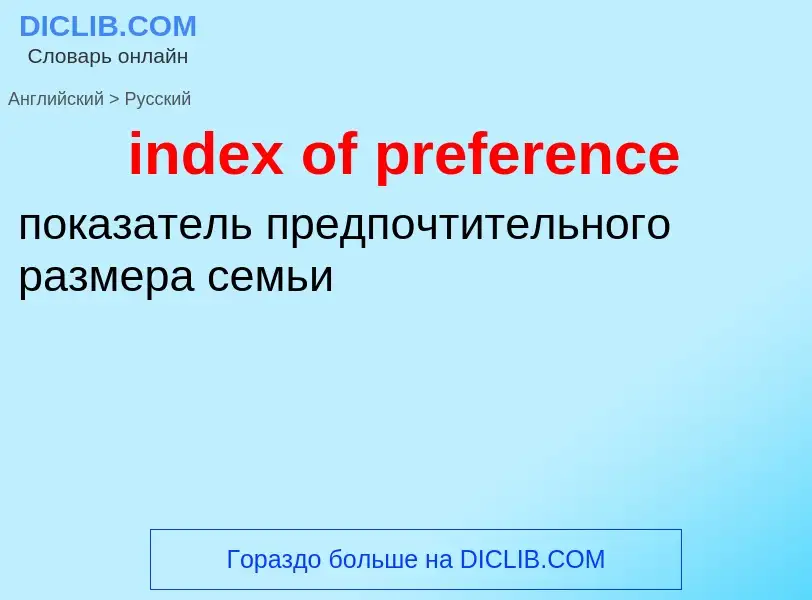Vertaling en analyse van woorden door kunstmatige intelligentie ChatGPT
Op deze pagina kunt u een gedetailleerde analyse krijgen van een woord of zin, geproduceerd met behulp van de beste kunstmatige intelligentietechnologie tot nu toe:
- hoe het woord wordt gebruikt
- gebruiksfrequentie
- het wordt vaker gebruikt in mondelinge of schriftelijke toespraken
- opties voor woordvertaling
- Gebruiksvoorbeelden (meerdere zinnen met vertaling)
- etymologie
index of preference - vertaling naar russisch
общая лексика
показатель преломления
оптика
коэффициент преломления
Definitie
Wikipedia
Imperial Preference was a system of mutual tariff reduction enacted throughout the British Empire following the Ottawa Conference of 1932. As Commonwealth Preference, the proposal was later revived in regard to the members of the Commonwealth of Nations. Joseph Chamberlain, the powerful colonial secretary from 1895 until 1903, argued vigorously that Britain could compete with its growing industrial rivals (chiefly the United States and Germany) and thus maintain Great Power status. The best way to do so would be to enhance internal trade inside the worldwide British Empire, with emphasis on the more developed areas — Australia, Canada, New Zealand, and South Africa — that had attracted large numbers of British settlers.
The Dominions enacted policies of imperial preference in the late 19th and early 20th century: Canada (1897), New Zealand (1903), South Africa (1903), and Australia (1907). Due to its commitments to free trade, Britain did not reciprocate these trade policies until the 1932 Ottawa Conference amid the Great Depression.
The Ottawa Agreement had little, if any, effect on intra-Empire trade.


![[[Diamond]]s have a very high refractive index of 2.417. [[Diamond]]s have a very high refractive index of 2.417.](https://commons.wikimedia.org/wiki/Special:FilePath/Brillanten.jpg?width=200)
![A [[calcite]] crystal laid upon a paper with some letters showing [[double refraction]] A [[calcite]] crystal laid upon a paper with some letters showing [[double refraction]]](https://commons.wikimedia.org/wiki/Special:FilePath/Calcite.jpg?width=200)

![power]] of a [[magnifying glass]] is determined by the shape and refractive index of the lens. power]] of a [[magnifying glass]] is determined by the shape and refractive index of the lens.](https://commons.wikimedia.org/wiki/Special:FilePath/Lupa.na.encyklopedii.jpg?width=200)
![Birefringent materials can give rise to colors when placed between crossed polarizers. This is the basis for [[photoelasticity]]. Birefringent materials can give rise to colors when placed between crossed polarizers. This is the basis for [[photoelasticity]].](https://commons.wikimedia.org/wiki/Special:FilePath/Plastic Protractor Polarized 05375.jpg?width=200)



![The colors of a [[soap bubble]] are determined by the [[optical path length]] through the thin soap film in a phenomenon called [[thin-film interference]]. The colors of a [[soap bubble]] are determined by the [[optical path length]] through the thin soap film in a phenomenon called [[thin-film interference]].](https://commons.wikimedia.org/wiki/Special:FilePath/Soap bubble sky.jpg?width=200)
![A [[split-ring resonator]] array arranged to produce a negative index of refraction for [[microwaves]] A [[split-ring resonator]] array arranged to produce a negative index of refraction for [[microwaves]]](https://commons.wikimedia.org/wiki/Special:FilePath/Split-ring resonator array 10K sq nm.jpg?width=200)
![In [[optical mineralogy]], [[thin section]]s are used to study rocks. The method is based on the distinct refractive indices of different [[mineral]]s. In [[optical mineralogy]], [[thin section]]s are used to study rocks. The method is based on the distinct refractive indices of different [[mineral]]s.](https://commons.wikimedia.org/wiki/Special:FilePath/Thin section scan crossed polarizers Siilinjärvi R636-105.90.jpg?width=200)
![Thomas Young]] coined the term ''index of refraction''. Thomas Young]] coined the term ''index of refraction''.](https://commons.wikimedia.org/wiki/Special:FilePath/Thomas Young (scientist).jpg?width=200)
![[[Total internal reflection]] can be seen at the air-water boundary. [[Total internal reflection]] can be seen at the air-water boundary.](https://commons.wikimedia.org/wiki/Special:FilePath/Total internal reflection of Chelonia mydas.jpg?width=200)
![Light of different colors has slightly different refractive indices in water and therefore shows up at different positions in the [[rainbow]]. Light of different colors has slightly different refractive indices in water and therefore shows up at different positions in the [[rainbow]].](https://commons.wikimedia.org/wiki/Special:FilePath/WhereRainbowRises.jpg?width=200)
